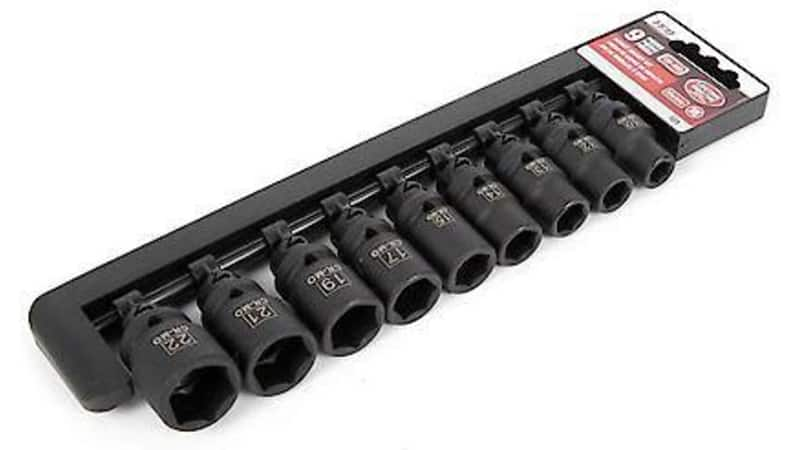Vehicle ownership comes with its own side bonuses and subcultures. While some are glamorous — car shows, racing, road trips and memorabilia — others are more about the everyday. Yup, we're talking tools.
Automotive tools help you get the job done right, but they can represent a significant investment. With these tool maintenance tips, your tools could last a lifetime.
Vehicle ownership comes with its own side bonuses and subcultures. While some are glamorous — car shows, racing, road trips, and memorabilia — others are more about the everyday. Yup, we're talking tools.
Automotive tools help you get the job done right, but they can represent a significant investment. With these tool maintenance tips, your tools could last a lifetime.
Air tools

Source | Advance Auto Parts
Pneumatics—tools driven by compressed air—are some of the most useful tools in a garage. From busting off a rusty axle nut to torqueing down lug nuts, air tools make everything easier. But they need a little extra care for a lifetime of use.
The air compressor's biggest issue is moisture. Normal air contains water vapor, and when compressed, the air heats up and condenses that moisture. Warm, wet air is a recipe for rust, so drain your compressor when finished using it for the day.
Of course, that warm moist air is running down the air hose to your tools, so you need some prevention there, too. Before use, add a few drops of oil to the air fitting of the tool. Use an approved pneumatic tool oil. If using throughout the day, take a break a few more times to re-oil, then hit it once again at the end of the day to prevent rust from forming overnight.
You can cut down on the amount of oil your tools need by increasing the quality of the air entering them. A filter/regulator/lubricator is a multitasking device that filters out damaging particles, maintains proper air pressure, and slowly feeds oil to the tools. This one tool is affordable insurance that can help all your air tools last longer.
Speaking of air pressure, maintain the pressure your tools were designed to use. While attempting to remove seized exhaust manifold bolts, you may be tempted to crank your impact with 800 psi, but don't go there. Too much pressure will cause excessive wear inside your tools. Use the proper psi and consider adding a quality air pressure gauge for confidence at a glance.
Hand tools
Source | Advance Auto Parts
From ratchets and sockets to wrenches and Torx bits, hand tools vary in use, complexity and price. While generally lower priced than air tools, your hand tools still need some work to last a lifetime.
The old joke is “Don't use your pliers as a hammer. That's what screwdrivers are for." You may think you're being an innovative MacGyver, but you're really more like a bumbling Red Green. Always use the right tool for the task at hand, according to the manufacturer's design. Here's why:
- First, you could break the tool if it isn't designed for a job.
- Second, you might damage your vehicle when the tool slips or can't complete the task.
- Finally, manufacturer warranties are a great deal, but have exclusions. Often, what you get is a limited lifetime warranty or replacement. The “lifetime" wording means the rest of your life, but the “limited" part means they don't cover abuse, which includes improper tool use.
If you're keeping hand tools to pass on to the next generation, you will need to prevent rust. The chrome plated vanadium steel on your TEQ Correct ratcheting wrenches looks great and resists rust. So does the black chrome plating on TEQ Correct sockets. While tough, these protective coatings can't do it all. Filthy tools corrode faster than clean ones, so take a minute to clean up your workspace and tools when you are done wrenching. You can wipe off most simple tools with a clean rag or scrub with an automotive soap when filthy. Wipe completely dry, then properly store in the tool chest. If you are really concerned about rust in a high-humidity location, pick up some rust inhibiting drawer liners.
Battery-powered tools

Source | Advance Auto Parts
Battery powered, or “cordless," tools can be the lightweight, portable and powerful solution many part-time mechanics need. Some gearheads don't trust the durability of cordless tools, often citing battery issues. Here's how you can fix that.
- Use them often. You should use cordless tools every month or two for most longevity. Look at purchasing a hand, air or electric version of the tool if it will only be used once a year.
- Don't run your battery to empty. The “battery memory" advice from years ago only applies to damaged ni-cad batteries. Feel free to recharge modern li-ion batteries when you notice the tool starting to slow down.
- Don't leave the battery on the charger, let it overheat, freeze or get wet. During winter, charge to roughly 50 percent, store in the factory case and keep in a climate-controlled environment.
- Finally, battery-powered equipment needs to stay clean, too. The intake or exhaust ports on drills and rotary tools can clog and impede performance. Cleaning with a soft brush will remove debris.
Benjamin Franklin said, “An ounce of prevention is worth a pound of cure." We're pretty sure he was talking about his garage tools, and it's still sound advice today. Take the time to treat them right, and your tools can last a lifetime.
Any more tips and tricks for reliable tools? Let us know in the comments below.









